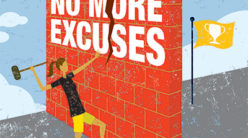Can there really be 50 ways to increase performance in your favorite sport? Twenty-five push-ups a day do not an athelete make, but combine those exercises you do for strength and endurance with a nutritious diet, aerobic conditioning, weight training, and a healthy lifestyle, and you can be at the top of your form-whatever your sport. Consider the suggestions below; you may be in for a few surprises.
1. Every athlete should have a baseline medical screen from which to work. Overtraining, illness, and stress can all affect performance. Fatigue sets in, and injuries may result. If you are over 40 and beginning an exercise program, make sure you get that physical.
2. Frequency, intensity, and time/duration are the components of a safe, effective exercise program. Mess up any of these, and you risk injury. Experts agree on a few basics: three or more workouts a week, at a heart rate not exceeding 60 to 80 percent of your maximum heart rate, for 20 minutes or longer. Even moderate exercise works to increase stamina.
3. Don’t accelerate your training level too rapidly. You need time to build confidence and accustom your muscles to any new activity. A beginner might benefit initially from working with a trainer to find the optimum level of activity. If you run, follow the 10 percent rule: do not increase mileage by more than 10 percent per week.
4. Know your limitations. If you are overweight and out of shape, you will need to lose weight as you shape up. Over age 40? Don’t try to run the marathon in two hours. Asthmatic? Don’t try to run through an attack. Whatever your health problem, work with it, not against it. Stay in touch with your doctor and/or trainer.
5. If you select activities you enjoy, you will increase your chances of sticking with them long enough to get in shape and feel good. Don’t take up running if you hate it; there are other ways to get in shape.
6. For the long haul, select at least one activity you can do anywhere with a minimum of fuss. Walking is great, possible in most climates, easy on the body, adaptable, and a great way to burn off extra calories you might take in at dinner, on vacation, or when on a business trip.
7. Many people benefit by joining an organization built around their sport or reading relevant material. Maintaining this contact helps the athlete take themselves and their sport seriously. Not only does this make the sport more fun, but it helps prevent staleness and encourages maximum effort.
8. Some athletes find that keeping a performance log or other type of progress chart aids them in sticking to their training regimen. Record each workout, and keep track in case you get injured. Looking back over your training and competition log may show you where you went off track.
9. Whatever sport you choose, make sure you don’t skimp on equipment. The right running shoe can make the difference between success and failure. Choose a cross-country ski machine that slides evenly, or you may end up with muscle pulls. Don’t take up bicycle racing and forget the helmet!
10. Successful athletes plan long-term. Think safety, as in adequate fluid intake, correct clothing for your sport and climate. Acclimate yourself gradually to extreme heat. During your first hot-weather workout, cut intensity by 65 to 75 percent; over the next several days slowly build back to your previous level. Wear reflective gear if you are outdoors after dark.
11. When working out, use the principles of overload, specificity, and progression. Overload is necessary to improve stamina, but don’t overdo. Irritability and depression are often the first signs of fatigue. Specificity means you train for what you want to achieve. Progression means that you keep on improving.
12. Work from a prevention perspective. If you have an injury that does not improve, see a specialist promptly. Untreated injuries may otherwise lay you up for long periods, during which stamina and endurance slide.
13. Remember the cardinal rules for every sport: warm up, stretch, and cool down. This is especially important if you are forced to be a weekend athlete. Don’t wait until the morning of your mountain climb to begin calf-stretching exercises, or you may find all your enthusiasm for the sport going up in smoke while you cool your heels for the next month.
14. If you are into heavy training for your sport, alternate hard and easy days. Weight training, for example, should not work the same muscles on consecutive days or you will be breaking down tissue instead of building. Long runs should alternate with short. Don’t perform an arduous rock climb two days in a row. On the night before that big whitewater trip, don’t max out on the rowing machine. Moderation is the word!
15. Cross-training is one of the most effective and safe ways to improve stamina and performance level, as well as a great way to avoid injury. Choose two or more activities that complement each other, such as weight training and trail running, or biking and swimming.
16. Rest, as in REST! Rest is as important for improving stamina as any workout. The results of overtraining are almost always bad, and they set you back.
17. The word on dietary supplements is NO. Unless your diet does not supply adequate nutrients you are wasting your money, and the same goes for ergogenic aids, according to Johann Coetzee, M.D., M.P.H., at the Cooper Institute for Aerobics Research in Dallas.
18. Maintain your ideal body weight, which takes into account your height and bone structure. Being significantly underweight is no more healthy than being overweight. Work with your activity level and your diet to maintain that balance. You may need to consult a nutrition expert if you don’t have a basic knowledge of nutrition.
19. You can’t do what you did 20 years ago–no matter who you are. Think safety, think long-term, think success. Less is more!
20. If all else fails, blame it on genetics. Maybe you just weren’t meant to climb rocks. Maybe your knees can’t hack running those rocky trails. Pursuing the impossible will not improve stamina; it will generate frustration and pain, and sideline you, the athlete. Pick something you can do.
21. Are you lacking power in your tennis game, or during your morning run? Are you doing sit-ups? Strong abdominal muscles not only help prevent or alleviate back problems; they also provide additional power for any activity involving the torso. Lie down, bend knees, feet on floor. Contract abdominal muscles, press back into the floor, rise to about a 30- to 45-degree angle.
22. Weight machines are great for building endurance for your sport and for shaping muscles. If you are new to weight training, consider joining a health club, where you can learn on variable resistance machines, such as the Nautilus system. These machines compensate for a muscle’s changes in strength by utilizing cams or levers to vary resistance, keeping it at a maximum level throughout the full range of motion.
23. Just how fast do you have to walk to qualify as a brisk walker? Four miles per hour is good, according to James M. Ripe, M.D., associate professor at Tufts University School of Medicine, and one of the nation’s foremost experts on exercise.
24. One of the best ways to add vigor to your life is to add strength training with weights to your lifestyle. Recent research at Tufts University found that women who worked with weights or weight machines for 45 minutes twice a week for a year emerged physiologically younger by 15 to 20 years than when they began.
The Food and Lifestyle Edge
25. If you follow a vegetarian diet and lead an active lifestyle, be sure you know what you are doing. Vegetarians who don’t eat dairy foods or other animal products need to use extra care to monitor their consumption of some nutrients that occur mainly or almost exclusively in animal foods. Vitamin B12 deficiency is especially common.
26. Sports Music, Inc., will provide a free catalog of audiotapes for every sport imaginable. Call (800) 878-4764, 9:00 to 6:00, EST, for some new tunes to put the “oomph” back in your workout.
27. Are allergies interfering with your sport? Call the American Academy of Allergy, Asthma, and Immunology at (800) 822-2762, a 24-hour hotline. They will send information, and can refer you to physician members of the academy.
28. Know the facts about metabolism-the rate at which you burn calories. The more muscle you carry, the higher your metabolic rate all of the time. This means you can eat more without gaining weight if you are active, better ensuring an adequate intake of necessary nutrients.
29. Choose a breakfast cereal that lists whole wheat, whole grain, whole oat flour, or rolled oats among the first ingredients. This ensures that the product has not been refined and is more likely to contain essential ingredients such as magnesium, manganese, chromium, and copper.
30. To ensure adequate calcium intake, consider these tips if you think you are lactose-intolerant. Consume small portions of low-fat dairy products; eat dairy products with meals or snacks; try yogurt with active cultures (provides enzymes necessary for its digestion); or search out calcium-fortified soy versions of these products.
31. Are you at your optimal weight? People with apple-shaped bodies have a greater risk of coronary artery disease, stroke, hypertension, and diabetes than their pear-shaped peers. Divide your waist measurement by hip measurement. A waist/hip ratio greater than 1.0 for men or 0.8 for women indicates increased cardiac risk, according to the American Heart Association.
32. If you are taking in enough fluids, your urine will run clear most of the day. For every pound you lose to sweat during a workout, you need to drink 16 ounces of fluids or you will become dehydrated.
33. Properly formulated sports drinks (those with 6 to 7 percent carbohydrate concentration) are absorbed 30 percent faster than water, and much faster than drinks with carbohydrate concentrations of 8 percent or more. Studies have shown they improve performance and combat fatigue during exercise sessions of an hour or longer because the body can use them right away.
34. Are you lacking the energy you used to have? Check your diet for “fat overload,” one cause not only of too much poundage but of lethargy. Frequent offenders: salad dressing, red meat, fried foods, ice cream, pastries, mayonnaise, whole milk. Read those food labels! Fat calories should number no more than 30 percent of your daily caloric intake.
35. Check out broccoli (a powerhouse of nutrition). One cup of broccoli equals 45 calories, and 90 percent of the daily requirement of beta-carotene, 200 percent of vitamin C, 25 percent of your fiber needs, and significant amounts of several minerals.
36. There’s nothing like irregularity to slow you down. Fiber, both soluble (oats, fruits, legumes, veggies) and insoluble (wheat bran, whole grains), are important for health. If you are not currently consuming 25 to 35 grams daily (five servings of fruits and veggies and about six servings of breads, cereals, and legumes), increase consumption gradually to allow your digestive system to adapt.
37. You want to save your energy for your sport and not spend it on the fight/flight response. Learn to relax under pressure. Deep breathing and imaging can help. Take a few deep breaths and imagine a beautiful scene. Worrying saps energy and can reduce stamina.
38. Music is a great motivator. If your sport or our workout session can be done with the accompaniment of music, you may find that extra burst of energy you need. Playing music regularly or occasionally will help you avoid getting stale. Increased effort builds stamina.
39. On t job, long stretches of sitting can weaken stomach and back muscles. Badly designed office furniture or auto seats make things worse. Get up and move around frequently. In your chair, stretch up tall with arms overhead; bend forward and touch the floor. Try clasping hands behind head and pulling elbows back gently. Hands clasped overhead, bend left, then right from waist.
40. When you travel on business, try to exercise first thing in the morning. This will help you acclimate to time changes. Later in the day, business meetings may prevent you from following your usual routine.
41. Working out at high altitude is significantly more demanding for the flatlander than for the mountain dweller. Unusually rapid heartbeat or difficulty breathing are signs that your body is not coping well. Stop exercising immediately. Cut back on your intensity during your stay; drink plenty of fluids; avoid alcohol.
42. Energy flagging? Try the full body stretch. Stand with arms relaxed at sides. Rotate head slowly forward, to left, back, to right. Then raise arms overhead and drop forward slowly, bending knees slightly to touch floor. Stretch back up slowly, arms overhead. Again, then relax.
43. Fat-burning is pretty straightforward. If you burn more calories than you take in over the course of a week or more, your body will start burning its fat stores, regardless of whether you burn fat or carbohydrates during any one workout.
44. Extra poundage is not only a health risk but can make you drag during your workouts. Consider that the government has released a more stringent height and weight table as part of its updated “Dietary Guidelines for Americans.” This new table does not allow for creeping poundage after age 35, as the earlier 1990 edition did. Shed that fat!
45. Don’t get sandbagged by osteoporosis just when you think life as an athlete is beginning. Call the National Osteoporosis Foundation, (800) 464-6700 (Monday-Friday, 8:00 a.m. to 9:00 p.m.; weekends, 9:00 a.m. to 5:00 p.m. EST), for the latest information. There is now a quick painless test to determine whether your bones are thinning.
46. Don’t let dinner out undo all your good work. Since 1991, restaurants have been increasing portions in response to demand. Ask for a doggy bag and take the extra home.
47. Any way you serve it, pasta contains about 210 calories a cup, and just one gram of fat. No wonder pasta (not the sauce!) is such an efficient fuel!
48. The most effective way to avoid catching those pesky office colds that drain your energy is to wash your hands. Avoid touching your nose and eyes with your hands; don’t share cups, pens, or phones with cold sufferers.
49. Ill-fitting shoes are thought to cause about 80 percent of all foot problems, and sore feet can knock you off your peak. When purchasing shoes measure both feet; wear the socks or stockings you will wear with those shoes; shop for shoes at midday or later.
50. Recovery from working out, from work, daily chores, and stress must take place or even the most gung-ho fitness fanatic will eventually crash. If you are not getting seven to eight hours of sleep a night, make some changes in your routine, or your energy will soon wane.






